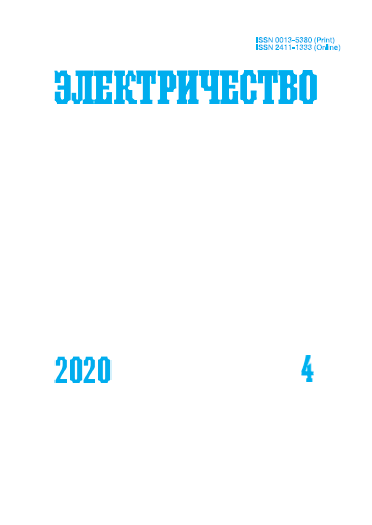Estimating the Effect of Gas Gap Nonuniformity on the Volume Barrier Discharge Characteristics
DOI:
https://doi.org/10.24160/0013-5380-2020-4-25-34Keywords:
volume barrier discharge, modeling, power density, ozone, coulomb-volt characteristicAbstract
The results from simulating the operation of ozone generators based on the volume barrier discharge
principle with taking into account the nonuniformity of their geometrical parameters are presented. The
effect the gas gap nonuniformity has on the barrier discharge power performance characteristics is
evaluated. The results from calculating the power density distribution along an ozone generator with a
monotonically varying gas gap size are presented. The power density distribution curves versus the gap width for different degrees to which the voltage exceeds its initial value are given for four types of ozone generators. New data on modeling the discharge processes in ozone generators with a nonuniform gap and on the influence of this nonuniformity on the discharge utilization efficiency are presented. The obtained results can be used in designing real ozonators, including large-capacity ones. Recommendations on selecting the optimal average gap size depending on the electrode manufacturing quality and on the gas gap setting up and adjustment accuracy are given.
References
2. Смородин А.И., Сторчай Е.И. Генератор озона нового поколения. М.: Изд-во МГТУ им. Н.Э. Баумана, 2017, 111 с.
3. Чепурнов А.В., Паолини Б. Совершенствование технологии синтеза озона. – Материалы 32-го Всероссийского семинара «Озон и другие экологически чистые окислители. Наука и технологии». М.: МГУ, 2012.
4. Лунин В.В., Попович М.П., Ткаченко С.Н. Физическая химия озона. М.: Изд-во МГУ, 1998, 480 с.
5. Темников А.Г. и др. Электрофизические основы техники высоких напряжений: Учебник для вузов. М.: Изд-во МЭИ, 2018.
6. Paschen F. Ueber die zum Funkenübergang in Luft, Wasserstoff und Kohlensäure bei verschiedenen Drucken erforderliche Potentialdifferenz. – Annalen der Physik und Chemie magazine, 1889, Bd. 273, Nо. 5, рр. 69–96.
7. Самойлович В.Г., Гибалов В.И., Козлов К.В. Физическая химия барьерного разряда. М.: Изд-во МГУ, 1989, 176 с.
8. Гибалов В.И., Питч Г. Численное моделирование формирования и развития канала микроразряда. – Журнал физической химии, 1994, т. 68, No. 65, c. 931–938.
9. Гибалов В.И., Питч Г. Выделение энергии в канале микроразряда. – Журнал физической химии, 1994, т. 68, № 6, с. 1130–135.
10. Гибалов В.И. О физической природе барьерного разряда. – Журнал физической химии, 1994, т. 68, № 5, с. 926–930.
11. Manley T.C. The electric characteristics of the ozonator discharge. Trans. Electrochem. Soc. 84, 1943, pp. 83–96.
12. Лысов Н.Ю. О вольт-кулонной характеристике генератора озона. – Материалы 31-го Всероссийского семинара «Озон и другие экологически чистые окислители. Наука и технологии». М.: МГУ, 2010.
13. ГОСТ 22372-77. Методы определения диэлектрической проницаемости и тангенса угла диэлектрических потерь в диапазоне частот от 100 до 5·106 Гц.
14. ГОСТ 1516.2-97. Электрооборудование и электроустановки переменного тока на напряжение 3 кВ и выше. Общие методы испытаний электрической прочности изоляции.
15. Kitayama J., Yagi Т., Ishida Т., Gotoh S., Esaki N., Ozawa T. Effects of dischargegap width and gas pressure on ozon generation characteristics of an air/fed ozongenerator. – Proc. of 13th Ozone World Congress. Kyoto, Japan, 1997, vоl. 2, pp. 791–796.
#
1. Lunin V.V., Samoylovich V.G., Tkachenko S.N., Tkachenko I.S. Teoriya i praktika polucheniya i primeneniya ozona (Theory and practice of obtaining and using ozone). Moscow, Publ. of Moscow State University, 2016, 416 p.
2. Smorodin A.I., Storchay Ye.I. Generator ozona novogo pokoleniya (New generation ozone generator). Moscow, Publ. of MSTU N.E. Bauman, 2017, 111 p.
3. Chepurnov A.V., Paolini B. Sovershenstvovaniye tekhnologii sinteza ozona. – Materialy 32-go Vserossiyskogo seminara «Ozon i drugiye ekologicheski chistyye okisliteli. Nauka i tekhnologii» (Improving the technology of ozone synthesis. - Materials of the 32nd All-Russian seminar «Ozone and other environmentally friendly oxidizing agents. Science and technology». Moscow, Publ. of Moscow State University, 2012.
4. Lunin V.V., Popovich M.P., Tkachenko S.N. Fizicheskaya khimiya ozona (Physical chemistry of ozone). Moscow, Publ. of Moscow State University, 1998, 480 p.
5. Temnikov A.G. et al. Elektrofizicheskiye osnovy tekhniki vysokikh napryazheniy: Uchebnik dlya vuzov (Physical chemistry of ozone). Moscow, Publ. of Moscow Pover Engineering Institute, 2018.
6. Paschen F. Ueber die zum Funkenübergang in Luft, Wasserstoff und Kohlensäure bei verschiedenen Drucken erforderliche Potentialdifferenz. – Annalen der Physik und Chemie magazine, 1889, Bd. 273, Nо. 5, рр. 69–96.
7. Samoylovich V.G., Gibalov V.I., Kozlov K.V. Fizicheskaya khimiya bar’yernogo razryada (Physical chemistry of a barrier discharge). Moscow, Publ. of Moscow State University, 1989, 176 p.
8. Gibalov V.I., Pitch G. Zhurnal fizicheskoy khimii – in Russ. Journal of Physical Chemistry), 1994, vol. 68, No. 65, pp. 931–938.
9. Gibalov V.I., Pitch G. Zhurnal fizicheskoy khimii – in Russ. (Journal of Physical Chemistry), 1994, vol. 68,No. 6, pp. 1130–1135.
10. Gibalov V.I. Zhurnal fizicheskoy khimii – in Russ. (Journal of Physical Chemistry), 1994, vol. 68, No. 5, pp. 926–930.
11. Manley T.C. The electric characteristics of the ozonator discharge. Trans. Electrochem. Soc. 84, 1943, pp. 83–96.
12. Lysov N.Yu. O vol’t-kulonnoy kharakteristike generatora ozona. – Materialy 31-go Vserossiyskogo seminara «Ozon i drugiye ekologicheski chistyye okisliteli. Nauka i tekhnologii» (About the volt-coulomb characteristic of the ozone generator. – Materials of the 31st All-Russian seminar «Ozone and other environmentally friendly oxidizing agents. Science and technology»). Moscow, Publ. of Moscow State University, 2010.
13. GOST 22372-77. Metody opredeleniya dielektricheskoy pronitsayemosti i tangensa ugla dielektricheskikh poter’ v diapazone chastot ot 100 do 5×106 Gts (GOST 22372-77. Methods for
determining the dielectric constant and the dielectric loss tangent in the frequency range from 100 to 5 106 Hz).
14. GOST 1516.2-97. Elektrooborudovaniye i elektroustanovki peremennogo toka na napryazheniye 3 kV i vyshe. Obshchiye metody ispytaniy elektricheskoy prochnosti izolyatsii (GOST 1516.2-97. Electrical equipment and electrical installations of alternating current for voltage of 3 kV and higher. General test methods for dielectric strength).
15. Kitayama J., Yagi Т., Ishida Т., Gotoh S., Esaki N., Ozawa T. Effects of dischargegap width and gas pressure on ozon generation characteristics of an air/fed ozongenerator. – Proc. of 13th Ozone World Congress. Kyoto, Japan, 1997, vоl. 2, pp. 791–796.




